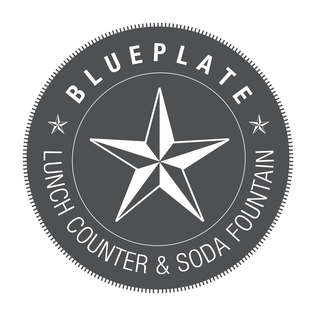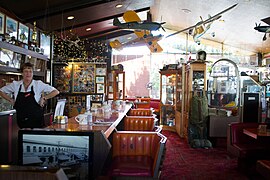
The F. W. Woolworth Company was a retail company and one of the pioneers of the five-and-dime store. It was among the most successful American and international five-and-dime businesses, setting trends and creating the modern retail model that stores follow worldwide today.

A sit-in or sit-down is a form of direct action that involves one or more people occupying an area for a protest, often to promote political, social, or economic change. The protestors gather conspicuously in a space or building, refusing to move unless their demands are met. The often clearly visible demonstrations are intended to spread awareness among the public, or disrupt the goings-on of the protested organisation. Lunch counter sit-ins were a nonviolent form of protest used to oppose segregation during the civil rights movement, and often provoked heckling and violence from those opposed to their message.
S. H. Kress & Co. was the trading name of a chain of five and dime retail department stores in the United States established by Samuel Henry Kress. It operated from 1896 to 1981. In the first half of the 20th century, there were Kress stores with ornamented architecture in hundreds of cities and towns.

J. J. Newberry's was an American five and dime store chain in the 20th century. It was founded in Stroudsburg, Pennsylvania, United States, in 1911 by John Josiah Newberry (1877–1954). J. J. Newberry learned the variety store business by working in stores for 17 years between 1894 and 1911. There were seven stores in the chain by 1918.

Frito pie is a dish popular in the Midwestern, Southeastern, and Southwestern United States, whose basic ingredients are chili, cheese, and corn chips. Additions can include salsa, refried beans, sour cream, onion, rice, or jalapeños. There are many variations and alternative names used by region. Frito pie can be prepared in a casserole dish, but an alternate preparation can be in a single-serve Fritos-type corn chip bag with various ingredients as toppings.

The Greensboro sit-ins were a series of nonviolent protests in February to July 1960, primarily in the Woolworth store—now the International Civil Rights Center and Museum—in Greensboro, North Carolina, which led to the F. W. Woolworth Company department store chain removing its policy of racial segregation in the Southern United States. While not the first sit-in of the civil rights movement, the Greensboro sit-ins were an instrumental action, and also the best-known sit-ins of the civil rights movement. They are considered a catalyst to the subsequent sit-in movement, in which 70,000 people participated. This sit-in was a contributing factor in the formation of the Student Nonviolent Coordinating Committee (SNCC).

The Nashville sit-ins, which lasted from February 13 to May 10, 1960, were part of a protest to end racial segregation at lunch counters in downtown Nashville, Tennessee. The sit-in campaign, coordinated by the Nashville Student Movement and the Nashville Christian Leadership Council, was notable for its early success and its emphasis on disciplined nonviolence. It was part of a broader sit-in movement that spread across the southern United States in the wake of the Greensboro sit-ins in North Carolina.
Seafoam salad, also known as orange salad, is a cafeteria and buffet staple popularized by F. W. Woolworth's lunch counters. Seafoam salad is often considered a dessert because of its sweetness, and so is one of many dessert salads. It is composed of green lime-flavored gelatin, cream cheese, pears, maraschino cherries, and whipped topping.
State of Iowa v. Katz was a landmark civil rights victory involving the Katz Drug Store in downtown Des Moines, Iowa.

Clarence Lee "Curly" Harris was the store manager at the F. W. Woolworth Company store in Greensboro, North Carolina, during the Greensboro sit-ins in 1960.
The Dockum Drug Store sit-in was one of the first organized lunch counter sit-ins for the purpose of integrating segregated establishments in the United States. The protest began on July 19, 1958 in downtown Wichita, Kansas, at a Dockum Drug Store, in which protesters would sit at the counter all day until the store closed, ignoring taunts from counter-protesters. The sit-in ended three weeks later when the owner relented and agreed to serve black patrons. Though it wasn't the first sit-in, it is notable for happening before the well known 1960 Greensboro sit-ins.

Franklin Eugene McCain was an American civil rights activist and member of the Greensboro Four. McCain, along with fellow North Carolina A&T State University students Ezell Blair Jr., Joseph McNeil and David Richmond, staged a sit-in protest at the Woolworth lunch counter in Greensboro, North Carolina, on February 1, 1960, after they were refused service due to the color of their skin. Their actions were credited with launching the Greensboro sit-ins, a massive protest across state lines involving mostly students who took a stand against discrimination in restaurants and stores by refusing to leave when service was denied to them. The sit-ins successfully brought about the reversal of Woolworth's policy of racial segregation in their southern stores, and increased national sentiment to the fight of African-Americans in the south.
February One is the name of the 2002 monument dedicated to Ezell Blair Jr., Franklin McCain, Joseph McNeil and David Richmond who were collectively known as the Greensboro Four. The 15-foot bronze and marble monument is located on the western edge of the campus of North Carolina Agricultural and Technical State University in Greensboro, North Carolina. James Barnhill, the sculptor who created the monument, was inspired by the historic 1960 image of the four college aged men leaving the downtown Greensboro Woolworth store after holding a sit-in protest of the company's policy of segregating its lunch counters. The sit-in protests were a significant event in the Civil Rights Movement due to increasing national sentiment of the fight for the civil rights of African-Americans during this period in American history.

David Leinail Richmond was a civil rights activist for most of his life, but he was best known for being one of the Greensboro Four. Richmond was a student at North Carolina A&T during the time of the Greensboro protests, but never ended up graduating from A&T. He felt pressure from the residual celebrity of being one of the Greensboro Four; his life was threatened in Greensboro and he was forced to move to Franklin, NC. Eventually, he moved back to Greensboro to take care of his father. Richmond was awarded the Levi Coffin Award for leadership in human rights by the Greensboro Chamber of Commerce in 1980. Richmond seemed to be haunted by the fact that he could not do more to improve his world, and battled alcoholism and depression. He died in 1990 and was awarded a posthumous honorary doctorate degree from North Carolina A&T

The Dime Store was a short-lived restaurant in Portland, Oregon, in the United States. It was established by Dayna McErlean, with additional conceptual development from Jeremy Larter. The restaurant opened in 2014, replacing Leo's Non-Smoking Coffee Shop, a diner which had operated for thirty years. The Dime Store's menu included diner classics such as burgers and milkshakes, along with all-day breakfast and weekend brunch specials. Despite garnering a positive reception, the restaurant closed in November 2015.

The sit-in movement, sit-in campaign, or student sit-in movement, was a wave of sit-ins that followed the Greensboro sit-ins on February 1, 1960, led by students at North Carolina Agricultural and Technical Institute (A&T). The sit-in movement employed the tactic of nonviolent direct action and was a pivotal event during the Civil Rights Movement.

The Original Dinerant, or simply The Original, is a diner serving American cuisine in Portland, Oregon, United States. Owned by Sage Hospitality Resources, Guy Fieri visited the "modern" and "upscale" diner to film a 2016 episode of the Food Network's Diners, Drive-Ins and Dives. The diner has hosted competitive eating contests and other special events. The Original has received a generally positive reception and is most known for its glazed doughnut sliders and alcoholic milkshakes. The restaurant's mezzanine level has an amusement arcade and bar called The Dinercade added in early 2019.

Blueplate Lunch Counter and Soda Fountain was a restaurant in Portland, Oregon, United States. Located in downtown's Dekum Building, the diner and lunch counter was established by chef–owner Jeff Reiter in 2006. The menu had American-style comfort food such as chicken and dumplings, French toast, meatloaf, and hot dogs, as well as banana splits, egg creams, milkshakes, and sundaes.

























